Fossil Track of “Bigfoot”: Metaphoric Buddhapada?
Posted by: Loren Coleman on September 7th, 2008
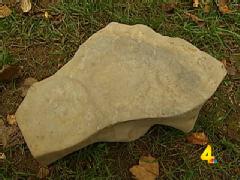
The Caney Fork River, Tennessee find.
Does anyone commenting on the so-called “fossilized Bigfoot track” know what he or she may be walking into? These are days of shooting fish in a barrel and any comment-maker better watch out that they don’t get hit from their blind side. The media are playing a strange game with “experts” they never have even talked to via a trap in Tennessee, and one that may be full of quicksand.
There seems to be a bit of nonsense coming from the Caney Fork River area, not so much from the folks down that way, but from what others who are reporting the news from there are saying.
People, from the media to others, have an agenda, and some people are getting caught up without looking at the greater context of where this might end.
First, a bit of background on the alleged series of footprints, which actually has only been shown to be one found “hominoid appearing imprint” from Tennessee.
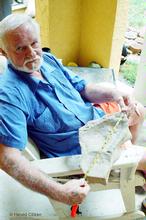
Harold Jackson (above with track), an amateur archaeologist who enjoys collecting arrowheads and other Native American artifacts, of Cookeville, Tennessee, was strolling around his property along the Great Falls Lake above the Caney Fork River when he and a friend noticed an impression in a nearby rock.
“(My friend said) ‘That looks like a footprint.’ I had seen it before, but I didn’t think anything about it,” said Jackson. “But then when my friend said that, I got to looking at it, and sure enough, (I thought), ‘It’s got to be a footprint.'”
“Jackson pried the fossilized print up from the surrounding rock and brought it home. As he rinsed off the mud, he was impressed at the detail in the impression. Not only was the outline of the foot clear, but also the impression of the toes, the heal and the ball of the foot. Looking at it from the side, he could see where the weight of the walker had pressed the now hardened mud tightly together directly under the print, whereas the fossilized mud down deeper was not as closely packed. After studying it closely, Jackson is still unsure of what the footprint is from, but whatever it was, it was big,” wrote Megan Trotter a few days ago in the local Herald-Citizen.
Jackson was quoted as saying: “I don’t know anything about archaeology or anything, but if you look at it, it’s a footprint. No animal footprint looks like that. Now, if it’s a Native American, an Indian, then he was a big Indian. This [print] is 11 inches across and 15 inches (long). And my foot’s about four and a half by about 10….It’s got to be thousand of years old.”
Wait a second. Jackson is an amateur archaeologist who knows nothing about archaelogy? Yeah, right. Someone is pulling our collective leg, right? But is it Jackson or the media? Down home phrasing to get your guard down?
Since the time when these local reports began, the news has gotten bigger and bigger. Apparently not tired of Sasquatch stories, in the least, this small news item has morphed into a Bigfoot curiosity piece, being picked up across the Internet.
According to the press accounts, about half-a-dozen scientists said they want to look at the print, including Dr. Jeffrey Meldrum, “a famous Bigfoot professor at Idaho State University,” as he was called by the media. But is this a truthful comment by the media grounded in any reality?
Jackson said the print has made him a “believer in big foot” out there, which has been “heard” by some as him saying “Bigfoot,” especially when Jeff Meldrum’s name was thrown into this.
“It was just hard for me to believe. But listen, after I found this print, there’s a big foot [written as ‘Bigfoot’ in the print media] out there somewhere. I don’t know what kind of big foot [again, as ‘Bigfoot’ in print] it is, but there’s a big foot [‘Bigfoot’] out there somewhere,” said Jackson.
Again, what?
In a recent trip back to the site where the print came from, Jackson came across what he believes may be the print of the right foot. This one is fossilized in a much larger rock – one Jackson is unable to pull out. So for now it remains where he found it.
“I’m not wanting any credit or anything for it. I just found it and thought it might be interesting to the people to see this,” Jackson told one reporter. “I’ve never seen anything like it.”
Meldrum and Media Madness
“Channel 4 has yet to reach Meldrum or Tennessee state archaeologist Nick Fielder to comment on the artifact,” reported one local television station.
I really have resisted even mentioning this story at Cryptomundo for days, because it frankly felt like a non-story. Someone finds what looks like a footprint in a type of rock not identified and bad photos are displayed. I was waiting for a bit more.
But during this crazy summer, the story has now jumped all around, from maybe one of a Native American to Bigfoot to Meldrum’s name being mentioned.
Why?
For instance, I tend to agree with skeptic Zoo Knudsen on this one. He observed, in part, at his blog: “The report sinks even lower into pseudojournalism when it is revealed, as if it is in some way meaningful, that Channel 4 has yet to even speak with Meldrum, or to reach Tennessee state archaeologist Nick Fielder for comment on the footprint. It isn’t news that you didn’t talk to somebody. You don’t get credit for not doing your job when it comes to reporting. I have no doubt that lots of famous and important people are interested in whether or not Bigfoot exists, and many reputable scientists would be qualified to discuss this finding, but just mentioning the name of one is obviously thrown in to lend more credibility to this worthless bit of fluff.”
Exactly.
Knudsen tries to get downright funny when he points out that in spite of headlines like “Scientists Interested In Large Footprint Discovery”, that “the only scientist specifially named as being interested in the discovery is oft quoted Dr. Jeffrey Meldrum, whose skeptical take on the recent Bigfoot corpse hoax was paraded around the news circuit as if it was some kind of unique opinion that required being a ‘Bigfoot expert’ to hold.”
I think this is all unfair and unkind to Meldrum. He’s not been contacted by the media and he’s being used incorrectly in this article to support the Bigfoot angle, which he did not bring up and which I find is a misreading of what Jackson even said.
Late update: Indeed, in an email just received, Meldrum just wrote me: “One look at the accompanying photo and it is obviously not a real footprint, let alone a fossilized sasquatch print.”
Pseudofossils and Petrosomatoglyphs
Some footprints are not real, such as the following:

The deeper I dug into this Tennessee story, the more I wondered why it had become as big as it has.
What is really here, anyway? Has anyone writing on any of the many cryptozoology, Bigfoot, or Fortean sites, forums, and lists talking about this considered that what might be here is, well, nearly nothing?
Most people can understand the concept that some natural objects, such as crystal formations in rocks, look like fossils. Those are called pseudofossils.
But I don’t think that’s what is going on in Tennessee. What I found when I was studying archaeology in my undergrad days in southern Illinois is that carved footprints in stone are usually the source of these midwestern American reports. Now, I’m not saying this is the verdict on this Tennessee one, because, as far as I have been able to see, no one with any training has examined it and, like I mentioned, the photos are not great.
But what this “footprint” might be is a petrosomatoglyph. A petrosomatoglyph is an image of parts of a human or animal body incised in rock. The word comes from the Greek petros (“stone”), soma (“body”), and glyphein (“to carve”). Feet are the most common; however, knees, elbows, hands, head and fingers are also found.
“A set of Jesus’s footprints, according to legend, are preserved at the Church of Domine Quo Vadis outside of Rome. In Buddhist symbolism, a Buddhapada (footprint of the Buddha) with Dharmacakra and Triratna symbols from the 1st century, is to be found at Gandhāra, Northern Pakistan….Footprints of the Buddha also exist in Afghanistan, Bhutan, Cambodia, China, India, Japan, Korea, Laos, Malaysia, the Maldives, Pakistan, Singapore, and Burma,” helpfully lists Wikipedia.

“Danger ahead, Will Robinson.”
No, I am not saying any theorists are involved with this Tennessee print, yet. But there is a history here that people casually moving into this story must realize.
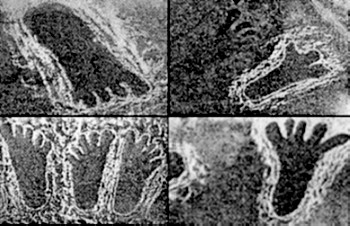
Rockcastle, Kentucky’s carved prints.
Real fossil footprints are often merged in with fake tracks to make some points.
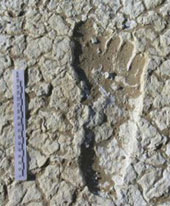
In August 2006, some perfectly good news was announced from New South Wales, Australia, about 20,000-years-old footprints of five human hunters shown sprinting across the soft clay on the edge of a wetland. Real fossil footprints do exist. But they are frequently mixed in with others that are not.
Are there dangers for anyone wanting to talk about the story of this supposedly “fossil track” from Tennessee?
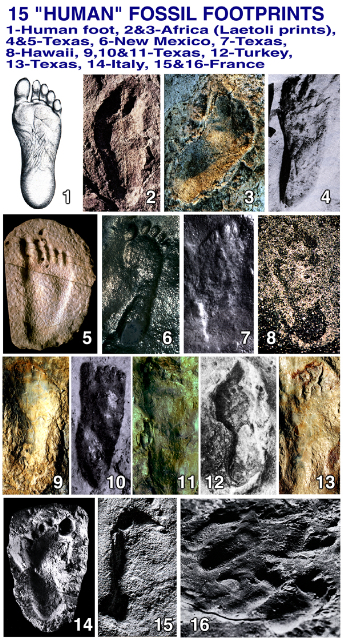
Unfortunately, the field of fossil footprints (carved, faked, even real and otherwise), in North America has often been politicalized, to serve as evidence of such things as the coexistence of humans and dinosaurs by a vocal minority, that the field of study is a mess, full of landmines.
Take, for example, the Omniology site, which has hoaxed pictures of “Civil War Pterodactyls” (that, of course, I know are fakes since I have a television prop example in my museum). The “omniologists” post their position that in various charts that all of the above and following are valid “fossil footprints,” to meet their own agenda.
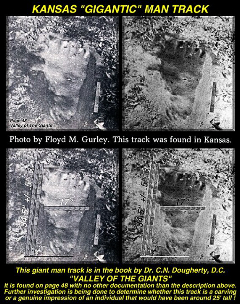
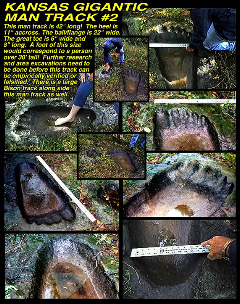
Besides the “track” found in a rock in Tennessee, first off, not even being yet a verified fossil, let alone one of a Bigfoot, I would just caution anyone against being dragged into a cultural war in a border state over this one. Let us not cruise along as if all this talk of a “Bigfoot” fossil track is to be taken seriously.
What seems to have occurred is a jump in logic from a not-too-large impression in stone evolving quickly into a “fossilized Bigfoot track,” as a metaphoric cryptozoological form of Buddhapada, with no disrespect to Buddhists.
What this depression in a rock is, whether a carving or an actual imprint of a human, remains to be seen. That it has anything to do with Bigfoot appears to be one of the greatest stretches of imagination, however, since that unpleasantness in Georgia.

About Loren Coleman
Loren Coleman is one of the world’s leading cryptozoologists, some say “the” leading living cryptozoologist. Certainly, he is acknowledged as the current living American researcher and writer who has most popularized cryptozoology in the late 20th and early 21st centuries.
Starting his fieldwork and investigations in 1960, after traveling and trekking extensively in pursuit of cryptozoological mysteries, Coleman began writing to share his experiences in 1969. An honorary member of Ivan T. Sanderson’s Society for the Investigation of the Unexplained in the 1970s, Coleman has been bestowed with similar honorary memberships of the North Idaho College Cryptozoology Club in 1983, and in subsequent years, that of the British Columbia Scientific Cryptozoology Club, CryptoSafari International, and other international organizations. He was also a Life Member and Benefactor of the International Society of Cryptozoology (now-defunct).
Loren Coleman’s daily blog, as a member of the Cryptomundo Team, served as an ongoing avenue of communication for the ever-growing body of cryptozoo news from 2005 through 2013. He returned as an infrequent contributor beginning Halloween week of 2015.
Coleman is the founder in 2003, and current director of the International Cryptozoology Museum in Portland, Maine.










At the least, Mr. Jackson should be warned against removing the supposed other footprint from the strata in which it is found. Much of the value of any artifact is destroyed by removing it from context before it has been properly documented and studied.
Thank you Loren, for presenting this story with the proper context, so we may try to form a proper opinion.
I agree that the history of weird footprints found in southern states of the US is full of landmines, with many people trying to see this as confirmation of their personal religious views.
Maybe people should pay attention to other stories that may yield better results in the overthrowing of the current paradigm, of how and when the first humans came to the Americas. Stories such as the skeleton dubbed “Eva de Naharon,” found in a underwater cave near Tulúm, México. This human fossil has been dated to be 13,600 years old, contradicting the academic “Clovis-first” theory.
Has Jimmy Chilcutt weighed in on this? Does Dr. Meldrum ever work with Jimmy on things like this?
What does it mean “he pried the fossilized print up from the surrounding rock”?
There was a rock that was lodged within a rock that he was able to pry loose?
People generally look ridiculous holding up plaster bigfoot footprint casts and now “pried” fossilized bigfoot footprint rocks.
Interesting story. I have heard that if you find an “artifact” that it must be turned over to the proper authorities, a civilian can’t simply keep artifacts. However fossils are a different story and are allowed to be kept. But I guess since there is debate over whether or not the alleged footprint is a fossil or an artifact makes this a little difficult to establish ownership.
I used to do alot of civil engineering work for municipalities that were funded with federal monies. My first experience with anything like that was a wastewater treatment plant way out in the woods near a creek (for the “clean” effluent to discharge). We had to have archeologists come to the site and so a field survey and in their small test digs they found “flakes”. No actual arrowheads, just flakes that they said that were remnants from Native Americans making tools, perhaps arrowheads, spears, cutting tools, from flint. Anyway, to make a long story short, that site got shut down and we had to find a new site that was a little farther away from the creek because the area around the creek was highly populated by the native americans and we would have had to pay big bucks for them to dig more and clear that site. And I helped them some while I was out there and they wouldn’t let me keep anything I found, it was illegal according to them to even keep an arrowhead if I found one. If I were the guy that found the “track” I would be hoping that I didn’t get into trouble for disturbing it.
It’s not a fake print, just the product of natural erosion. reminds me of the moss covered world war two body found on a hike in austrailia, turned out to be a moss covered branch hanging in some vines. Looked like a body at first glance though, same with this “print”.
Arrowheads can be kept if they come from private land. It is artifacts found on government or BLM land that poses a problem.
Fossilized human prints have been found in America, so this isn’t unprecedented. All a bigfoot would have had to do is walk across an appropriate medium for the footprints to be captured (i.e., mud, ash, sand, etc.) and have it followed by a sudden environmental event that would allow for the fossilization process to begin.
Reasonably, there should be evidence of a trackway, not just one or two prints. I hope he leaves the other one in situ so it can be properly studied.
What I find most problematic is the shape of the rock holding the print. As an archaeologist, I am very familiar with people trying to steal pictographs/petroglyph from rock art panels. The thieves are almost always unsuccessful in getting out a complete artifact as they underestimate how far away from the picture they have to start chiseling, the correct angle, how much rock fractures, etc. If he truly chiseled that out of a larger rock, it had to have been bigger at one time and he’s reduced it’s size OR the footprint was added to the rock after the fact, either by Native Americans (a petroglyph) or by someone more recently.
An inspection should be able to tell if it’s a fossil, petroglyph or something else.
And yes, it is illegal to collect any artifact (historic bottles, Civil War buttons, arrowheads, etc.) off of Federal or State owned land. However, if the artifact is on your own property or you have permission from the property owner to collect, it is not illegal.
I really like Loren’s clear headed, rational take here. I have to say I agree completely.
One thought I’d throw out there is that it is important not to underestimate the human mind’s tendency to try to find patterns in natural objects, and to especially see human qualities. There is a very strong urge to anthropomorphize things, both living and non living, as well as to find patterns in chaos. Thus we see tree stumps in the form of human faces or bodies, wood grain in the form of human images, humanoid faces on Mars, the list goes on and on.
In my opinion, it is quite common to pick out human faces or forms in naturally occurring objects and I think this can definitely happen with some of the alleged fossil footprints, handprints, and so on. Some are real, of course, but it is worth keeping in mind that there is the possibility for someone to find a rock that has naturally become shaped to resemble a footprint and then jump to the conclusion that that is what it must be.
Until more is known about these particular prints, and a proper inspection is done, I think it is a possibility to consider.
The media is really starting to both trouble me, and tick me off…in this Georgia debacle, the media apparently (and I mean most every group that reported on this), did no background looking into the situation…that story ended up on our front page paper (must have been a reallllllllly slow news day or something)–for all of us here and other sites, it was looking up to be hoax from the get go and most of the news groups treated it like breaking news and took for granted that it was on the level.
The news in general seems to have lost much of its objective manner…jumping into stories and then doing the ole–“whoops, we had it wrong, it was this instead,” but we did get you to watch our channel/read our paper, etc.
I don’t know if the news has become ALL about ratings or journalists are just getting really sloppy, but it is not a good thing. And these latest three ring hoaxes have not done anything to give me confidence in the news media!
The media just can’t get enough of Bigfoot these days. He’s replaced Paris Hilton, they’re rabidly seeing what he’ll (supposedly) be involved in next…sad. But then again with those charming good looks…. 😉
There was for many years, and probably still, a rock of very similar size and shape that made it’s home on a beach in Belfast, ME. I can’t recall anyone ever postulating that it was anything other than a really interesting rock. Although we did on occasion discuss giving it a new home, but it was quite heavy, so we left it as we found it.
Maybe we should have taken a better look, eh?
How about we wait and see?
I really don’t think it is a bigfoot track, but it isn’t as obviously symbolic art as the somataglyphs, though it also doesn’t resemble the real footprints, either.
But what is wrong with waiting and seeing?
Good point, Sschaper. Although I tend to agree with Loren.
okay what really presses my buttons is people who say, no one ever saw a bigfoot before the 1900’s so its fake. not true! sasquatch is an american indian name, do you think thats a coincidence, i thought not. and the american indians told of these creatures being the boss of the woods,the biggest and the strongest in the forest! On top of that they put sasquatch faces on every kind of artifact imaginable. They have some later day masks, these show a great ape face like that of a gorilla, how would they know what that is without a single primate in the us with the exception of themselves.
jtm_kryptos, your heart is in the right place and you are correct about First Nations’ people encountering hairy upright primates. But “Sasquatch” was coined by a British Columbian newspaperman, J. W. Burns. It might have been based on Native words, but it is almost as Euroamerican as “Bigfoot,” if you think about it.